Kostenloser Versand ab 35€ Bestellwert!
-
Shop
- Insights
-
Über ROMBO
- Händler
- Plektren-Finder
- Geschenkgutschein
+Kategorien
- accessories
- bass
- bass pick
- bass picks
- bass plectrum
- bass plectrums
- beginner
- bright tone
- chose guitar pick
- chose guitar picks
- chose plectrum
- chose plectrums
- CrystalBright
- Diamond
- Diamond pick
- discipline and guitar
- DIY generation
- durability pick
- durable pick
- eco
- ecoblack
- find guitar pick
- find plectrum
- fingers vs picks
- grip
- grip guitar pick
- guitar accessories
- guitar advantages
- guitar benefits
- guitar career
- guitar health
- guitar injury
- guitar learn
- guitar lesions
- guitar lesson
- guitar method
- guitar noise
- Guitar noise plectrum
- guitar pain
- guitar pick
- guitar pick beginner
- guitar pick bevel
- guitar pick buy
- Guitar pick diamond
- guitar pick durability
- guitar pick durable
- guitar pick eco
- guitar pick features
- guitar pick grip
- guitar pick material
- Guitar Pick Noise
- Guitar Pick online
- guitar pick recycled
- guitar pick recycled material
- guitar pick special features
- guitar pick textures
- guitar pick thickness
- guitar pick variable thickness
- guitar picks
- guitar tone
- guitar warm-up
- guitarpick
- guitarpicks
- hold a guitar pick
- hold guitar pick
- hold guitar picks
- hold pick
- hold plectrum
- hold plectrums
- how to
- how to chose your guitar picks
- jazziii
- learn guitar
- lose guitar pick
- material
- materials
- mental health and guitar
- motivation and guitar
- music
- not to lose guitar pick
- Online guitar
- online guitar pick
- online guitar pick buy
- pick
- pick durability
- pick material
- pick noise
- Picks
- picks vs. fingers
- play bass fingers
- play bass picks
- play bass with fingers
- play bass with pick
- play bass with picks
- play bass with plectrum
- play guitar faster
- plectrum
- plectrum attributes
- plectrum beginner
- plectrum bevel
- plectrum characteristics
- plectrum features
- plectrum grip
- plectrum material
- plectrum noise
- plectrum recycled
- plectrum shape
- plectrum variable thickness
- plectrums
- Plek
- pua
- recycled
- recycled guita pick material
- recycled guitar picks
- recycled picks
- recycled plectrum
- Rombo Diamond
- rombopicks
- tendonitis guitar
- the guitar pick
- tone
- variable thickness
- warm tone
- warm-up guitar

8 Myths about guitar picks
8 Myths about guitar picks
We have been in the guitar pick industry for a couple of years now. During this time, numerous customers have sent lots of inquiries with repeated questions and myths.
We have summarized the top 8 myths that “shocked” us the most, and we explain why they don’t make any sense!

1st Myth: Guitar picks don't influence guitar tone.
In guitar picks, qualities like thickness, material, shape, and size play a pivotal role in tone, feedback, grip, guitar pick noise, sustain, etc…
Why this happens has a simple explanation: Different shapes or materials make the guitar strings vibrate in different patterns.
In our article “Do guitar picks really affect the tone of your guitar” we discuss all the aspects in detail.
2nd Myth: There is a "best" pick for everything
The guitar is one of the most popular instruments because it is versatile. This versatility is achieved by a broad range of techniques. Different techniques require different picks.
Like in every guitar aspect, there is no "better" or "worse".
If you are looking for a brighter sound, then Tortex might be your choice. Nevertheless, if your aim is to get a warmer/darker/deeper tone, other materials like Nylon could perform way better.
The same applies to guitar pick thickness, shape, size, the grip texture, etc.
I recommend having at least 3 to 5 guitar picks for different specific usages. If you do not know where to start you have three options:
- Learn about guitar picks
- A Variety Pack
- Get advice (free advice here)

3rd Myth: You don't need picks if you know how to play with your fingers
Both methods are valid and appropriate for the right musical context. Your goal as a musician is to be able to create the sounds you imagine. The method is up to you!
However, some basic techniques like tremolo picking, palm mute, pinch harmonics, or pick slides are very difficult to perform with fingers. Even more, they are also faster to learn if you use guitar picks. This point also plays a role in keeping your motivation at a high level.
If you love both picking methods you’ll end up with a broader technique repertoire and will profit from both worlds.
4th Myth: Bryan May uses a coin. Everyone should do the same.
You can make a pick out of every item, a penny, paper, old credit cards, or anything else. The important thing here is the joy of exploration. Not the specific taste of one excellent influential guitarist.
Imagine how much you’ll limit yourself if you make the wrong decisions at the beginning of your career.

5th Myth: Guitar picks don't have an influence on speed.
Some qualities like pick shape, a beveled edge, and a polished guitar pick can play an important role in your speed.
“Real” guitar shredders use thick and pointy guitar picks. Probably this combination is the best place to start if you are looking for guitar speed. But remember, the most influential factor when it comes to developing speed is the number of hours of deliberate training!

6th Myth: Once you find a pick that works for you, stick to it forever.
If every song has different requirements, why always use the same guitar pick?
Different guitar picks make a difference in your tone and your playing.
I am not saying that’s impossible to play a “master of puppets” with a 0.38 mm rounded guitar pick. It is all a matter of practice and habits. However, with the right tools, you will learn faster.
In this case, for such a song with lots of palm-mute and downpicking, I would choose a thick, pointy, durable guitar pick, like Rombo Diamond.

If later today, I’m feeling like playing bossanova-jazz phrases with my semi-hollow guitar, I’ll probably use a rounded medium pick. Preferably our of Nylon.
7th Myth: Guitar picks are expensive
This is one of the most controversial aspects related to guitar picks.
You can find arguments for both the “cheap” and the “expensive” side.
Argument: “Guitar picks are expensive”:
- It’s just a piece of plastic
- I’ll lose it very fast
Argument: “Guitar picks are actually cheap”
- If it is a good one, I can use it for over 200 hours (more on durability here)
- It’s the fastest way to change the tone of your guitar
- It’s the bridge between your hands and your instrument and it deserves more attention.
- It costs less than a cup of coffee.
Put in perspective, when you purchase a guitar pick you don’t only “buy a piece of plastic”. Behind the shape and the material development there is a lot of engineering going on.
In addition, you are supporting the infrastructure behind it (customer support, web development, logistics, production, marketing, distribution, R&D, packaging,...). Without one of these single elements, there won’t be guitar picks.
8th Myth: After five seconds on the floor, a pick disappears and goes to an unknown dimension.
This happens after only three seconds, not five.

WIE ÜBER 2000 GITARRENSPIELER UNS GEHOLFEN HABEN, UNSERE GITARRENPLEKTREN FÜR 2023 ZU GESTALTEN:
Im Juni 2022 haben wir die ersten 3D-Skizzen unserer vier neuen Plektrum-Modelle fertiggestellt. Die Picks waren jedoch nicht zu 100 % fertig.
Die Dicke, Größe und sogar die Namen der Plektren waren noch nicht definiert.
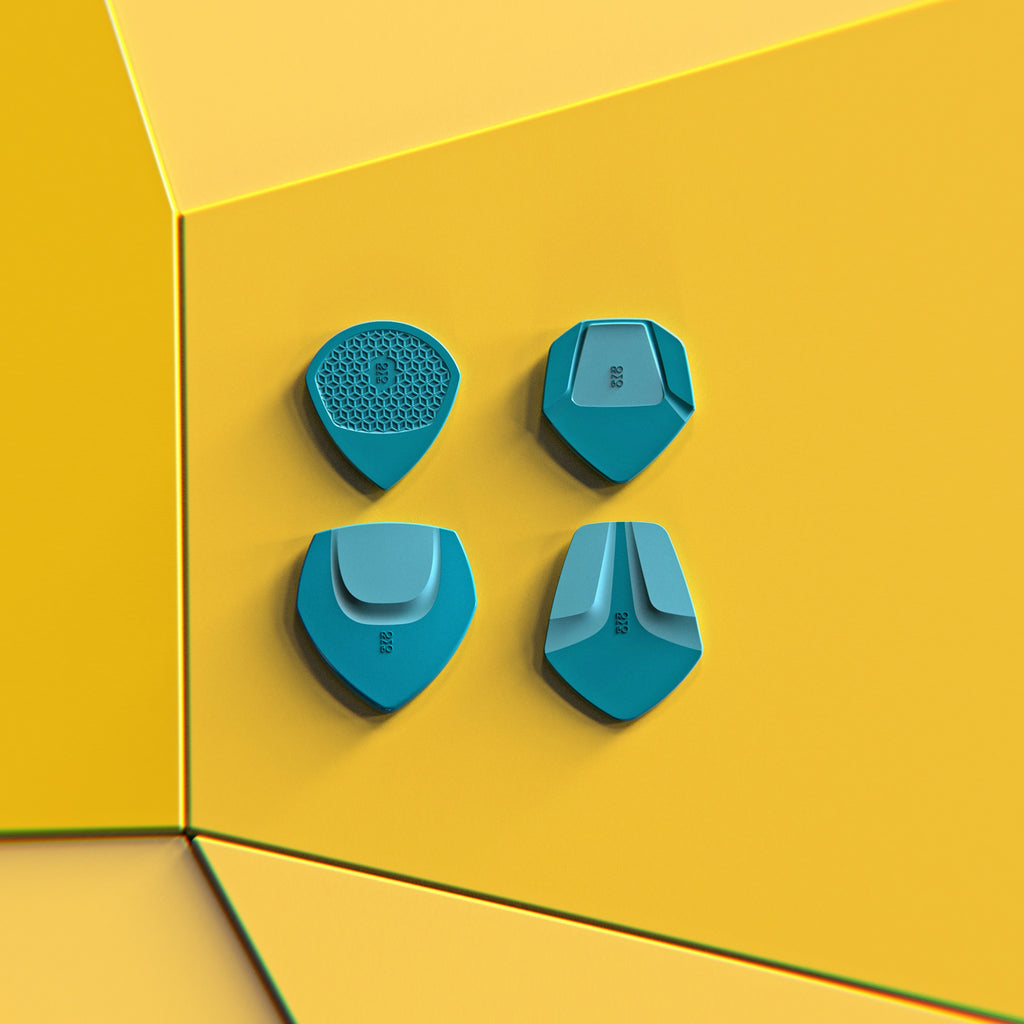
Wir haben uns für den Ansatz entschieden, so viele Gitarristen wie möglich einzubeziehen, um uns beim Co-Design unserer neuen Gitarren-Plektren zu helfen.
Das Ziel dieses Artikels ist es, die Ergebnisse der Umfrage zusammenzufassen, an der 2122 Gitarristen teilgenommen haben. Diese Leute haben das endgültige Design unserer Picks direkt beeinflusst.

Die Gitarren-Community hat Rombo seit seinem Start im Jahr 2019 stark unterstützt.
Wir wollten keine neuen Gitarrenpicks kreieren, ohne die Leute zu fragen, die von Anfang an dabei waren. Sie alle sind der Kern von Rombo, und Sie sollten entscheiden, welche Produkte wir entwickeln.
Der logischste Schritt war, eine große Umfrage zu erstellen, die es der Community ermöglicht, uns mitzuteilen, wie sie ihre Gitarrenplektren gern hätten. Wir glauben, dass dies der einzige Weg ist, ein Produkt zu entwickeln, das auf den Wünschen unserer Community basiert und uns ermöglicht, grundlegende Entscheidungen über die Ausrichtung unseres Unternehmens zu treffen.

Dies ist nur möglich, wenn man auf die Gedanken jedes Gitarristen hört.
GUITAR PICKS 2023 - ERGEBNISSE DER UMFRAGE
2122 Gitarristen haben an der Umfrage teilgenommen und sich somit am Designprozess dieser neuen Gitarren-Plektren für 2023 beteiligt.
509 von ihnen hinterließen eine private Nachricht mit detaillierten Informationen.
Weiter unten gehen wir auf diese Nachrichten ein.

WAS IST IHR LIEBLINGS-GITARREN-PICK-DESIGN?


Es gibt einen klaren Gewinner. Gitarrenplektrum Nummer 2 ist der Favorit für die meisten Teilnehmer.
Könnte es an seiner Ähnlichkeit in Form und Größe mit dem legendären Jazz-III-Gitarrenpick liegen?
Überraschenderweise ist Nummer 4 das Gitarrenplektrum, das mich während des Prototypentests am meisten überrascht hat. Aber natürlich weiß man nie, bis man es probiert hat!
GITARRENPICK NUMMER 1:

Name:
- Mosaic: 33,4%
- Pegasus: 16,6%
- Sense: 13%
- Summit 6,8%
- Andere Namen: 30,2%
Durchschnittliche Dicke: 0,66 mm
Größe: Kleine Größe mit 89 % der Stimmen
GITARRENPICK NUMMER 2:

Name:
- Shell: 42 %
- Lance: 18%
- Turtle: 8,2%
- Andere Namen: 31,8%
Durchschnittliche Dicke: 0,953 mm
Größe: Mittlere Größe mit 77 % der Stimmen
GITARRENPICK NUMMER 3:

Name:
- Erebus: 52%
- Quasar: 32,1%
- Jupiter: 10,1%
- Moon: 5,15%
- Andere Namen: 0,65%
Durchschnittliche Dicke: >2 mm
Größe: Große Größe mit 55 % der Stimmen
GITARRENPICK NUMMER 4:

Name:
- Dune: 39,8%
- Lance: 31,2%
- Doppler:19,6 %
- Sense: 4,7%
- Andere Namen: 4,7%
Durchschnittliche Dicke: 0,72 mm
Größe: Mittlere Größe mit 85 % der Stimmen
GUITAR PICKS: PERSÖNLICHE GEDANKEN VON 509 GITARRENSPIELERN

Insgesamt 509 Personen haben uns eine private Nachricht bezüglich Gitarrenpleks hinterlassen.
Wir haben sie alle sorgfältig gelesen und werden alle diese Informationen während der Entwicklung berücksichtigen.
Hier sind die 10 häufigsten Fragen, die wir wiederholt erhalten haben, und unsere Kommentare dazu:
● Werden die Plektren in verschiedenen Farben erhältlich sein?
Ja! Die Markteinführung umfasst alle regulären Rombo-Farben.
Weitere „Special Edition“-Farben sind in Vorbereitung.
● Werden sie die gleiche Griffstruktur haben?
Viele Leute haben uns E-Mails und Briefe bezüglich der Griffstruktur geschickt. Mit den Mikronoppen haben wir den Vorteil von mittelgriffigen Oberflächen, die viel Kontrolle hinzufügen.
Eine sehr kleine Anzahl von Menschen möchte jedoch, dass die Picks mehr Grip haben. Wir mussten hier eine Entscheidung treffen, und es war schwer. Wir werden die „Korndichte“ auf den strukturierten Bereichen leicht erhöhen, sodass mehr „Micro nodules“ pro Quadratmillimeter entstehen.
Auf diese Weise hoffen wir, den Bedürfnissen aller Gruppen gerecht zu werden.
● Das Material ist kühl, erzeugt aber warme und sanfte Töne. ich bevorzuge
helle Töne. Plant ihr ein neues Materialsortiment?
Wir haben unser Materialkomposition absichtlich geschaffen, um diese sanften Töne zu erreichen. Etwa 12 % der Benutzer gaben jedoch an, helle Töne zu bevorzugen.
Wir haben beschlossen, mit der Forschung an einem neuen Material zu beginnen, das als zusätzliches Sortiment auf den Markt gebracht wird, sobald wir die richtige Formel gefunden haben. Das voraussichtliche Datum für die Markteinführung des neuen Materials ist Anfang 2024.
● Warum erstellt ihr nicht für jedes Plektrum unterschiedliche Dicken?
der Modelle?
Wir möchten, dass jedes Plektrum einzigartig ist. Da jeder Mensch individuelle Vorlieben hat, glauben wir, dass jedes Plektrum sein eigenes Design haben sollte. In Zukunft hoffen wir, eine breitere Palette von Plektrumdesigns erstellen zu können, um jedes mögliche Bedürfnis abzudecken.
● Was ist mit Plektren für Bassisten?
Die meisten unserer Plektren sind mit Bass kompatibel, wie wir bei einigen Bassisten bestätigt haben, die sie regelmäßig verwenden, insbesondere Rombo Diamond und Rombo Origami. Das haben wir HIER erklärt.
● Ihr solltet Merch, T-Shirts und andere Dinge anbieten:
Vielleicht in der Zukunft. Jetzt wollen wir uns zu 100% auf die Entwicklung der Gitarrenpicks konzentrieren. Jede Minute, die wir für das Design eines T-Shirts aufwenden, wird von der Qualität der Picks abgezogen! ;)
● Werdet ihr die EcoBlack-Reihe in anderen Farben anbieten?
Das EcoBlack-Material kann derzeit nur einfarbig produziert werden.
Durch den Recyclingprozess entsteht eine sehr dunkle Pigmentierung. Die Industrie arbeitet hart daran, einen Weg zu finden, neue Recyclingverfahren zu schaffen. Wir hoffen, dass wir in Zukunft alle unsere Plektren aus recyceltem Material herstellen werden.
● Warum erstellet ihr keine Boutique-Picks?
Gegenfrage: Was ist ein Boutique-Plektrum?
Ein Boutique-Plektrum ist ein einzigartiges Kunstwerk in Form eines Plektrums, das ihr zum Gitarrenspielen verwenden könnt. Normalerweise sind diese Plektren handgefertigt und aus exotischen Materialien. Sie enthalten einige künstlerische Elemente wie Ornamentgeometrien und sind in der Regel einzigartige Sondereditionsstücke mit erhöhten Startpreisen.
Unser Ansatz ist ein anderer. Wir kreieren Boutique-ähnliche Gitarren-Pick-Designs zu sehr erschwinglichen Preisen. Andernfalls wären nur ein paar Rombo-Designs für die einflussreichsten Pick-Sammler verfügbar.
Wir glauben, dass wir auf diese Weise eine Nische zwischen Massenproduktions-Picks und einzelnen Sondereditionen gefunden haben. Mit diesem Ansatz bringen wir das Boutique-Feeling zu einer größeren Anzahl von Menschen und stärken die Plektrum-Community und das Bewusstsein für dieses kleine, aber wichtige Accessoire.
● Einige Plektren, die ich 2019 bestellt habe, hatten Grate. Dies ist kein Problem für
spielen, aber es sieht nicht cool aus.
Wir haben gute Nachrichten für Sie. 2021 haben wir eine neue Methode entwickelt, um die Grate manuell von den Plektren zu entfernen. Das bedeutet, dass alle Rombo-Picks manuell überarbeitet und bearbeitet werden, um alle visuellen Aspekte zu entfernen, die nicht zum ursprünglichen Design gehören (wie kleine Grate an der Umrandung).
Dies hat uns zusätzliche Zeit gekostet, aber als Premium-Marke müssen wir unsere Qualitätsstandards ständig verbessern, um sicherzustellen, dass eure Plektren so gut sind, wie ihr es erwartet!
● Warum nochmal Kickstarter?
Siehe unten :)
WANN SIND DIE NEUEN PICKS VERFÜGBAR?
Die neuen Gitarrenpicks kommen im Frühjahr 2023 auf den Markt.
Wenn ihr eine E-Mail erhalten möchtet, sobald die Picks verfügbar sind, abonniert unseren Newsletter (siehe Fußzeile).
Dies ist der Zeitplan, den wir für dieses Projekt erstellt haben:

WARUM KICKSTARTER?
Kickstarter-Kampagnen lassen Träume und Ideen Wirklichkeit werden. Rombo ist immer noch ein kleines Start-up, das von zwei Personen geführt wird und nur begrenzten Zugang zu Ressourcen hat. Über Kickstarter binden wir die Community der Gitarristen ein und zeigen unsere Gitarrenplektren vor dem Start.
Dieser Prozess bringt uns in Kontakt mit den echten Gitarristen. Es zwingt uns, flexibel zu bleiben, Änderungen zu akzeptieren, und es fordert uns heraus, neue Designs zu entwickeln, um die Erwartungen unseres Publikums zu erfüllen.
Wir lieben offene und kritische Kritik, und dies ist der beste Ort dafür, wo alle Kommentare und Gedanken sichtbar sind. Indem wir Ihre Erfahrungen teilen, können wir auf eure Bedürfnisse und Wünsche eingehen und Gitarrenplektren entwickeln, die einen Unterschied machen.

Thick Guitar Picks vs Thin Guitar Picks
Thin guitar picks vs. thick guitar picks. This eternal battle has been a part of every guitarist's conversation for decades. It is time to finally evaluate both alternatives in depth.
The thickness of a guitar pick is generally measured in millimeters, and it is an attribute that influences many physical aspects like tone and flexibility. For most players, this is considered the most important attribute when choosing the right guitar pick.

However, after doing some online research, nobody seemed to really know how thick a guitar pick needs to be to be considered as a thick or heavy guitar pick. Where is the line?
Therefore, the first thing we did was to create a big online survey on our Instagram guitar community.
1- What are considered Thick Guitar Picks? Thoughts from the Guitar Community
The survey we created was online for 24 hours on an Instagram story and the participants were asked to answer two simple questions.
Personal preferences - thick picks or thin picks?
This question was the first one, and its aim was to see if guitar players prefer thick or thin guitar picks. Here are the results:

It seems that over two thirds of the guitar players prefer guitar picks considered as thick. Honestly, I thought there would be a 50-50 relation and this surprised me a lot.
What do you consider as a thick guitar pick?
This was the second question, and the guitar players could select different thicknesses they considered to be the “least thickness needed for a guitar pick to be considered as thick or heavy”.

The results showed that on average, a pick must be at least about 1.0 mm to be considered as a thick guitar pick.
These results are very interesting, since the information we found during the research claimed that a pick is considered as “thick” or “heavy” if it surpasses 0.8 mm thickness. We did not find any study or survey with more participants than ours.
Of course, we have to consider that we do not have any way to track more specific characteristics of the participants like skill level, music preferences, guitar type, age, and so on.
Average thickness of guitar picks over time
Additional research on this topic showed that during the past decades, the average thickness of the guitar picks has increased substantially. Thin guitar picks are even considered as vintage by many players due to the tone they produce.
This is no surprise, given that most modern guitar techniques and effects that require thick picks (like shredding) were non-existent during the 1950s and 1960s.

2- Why does guitar pick thickness matter?
The thickness of a guitar pick is one of the most influential attributes.
The guitar pick thickness influences:
- The flexibility of the pick
- The tone produced by the pick
- Volume and body of single notes
- The pick noise created by the pick
- The durability of the pick
- The control over the pick
- The feedback you will receive from the pick
A minimal change in the thickness of a guitar pick of only 0.2 millimeters (equal to two common paper sheets) is enough to change the properties of a guitar pick drastically.

3- Thick guitar picks vs. thin guitar picks:
Let's pretend there are no medium guitar picks and create a clear line that divides both thickness ranges, to make the differences between thick picks and thin picks more appreciable.
|
|
Thick / heavy guitar picks |
Thin guitar picks |
|
Flexibility |
Rigid/very rigid |
Flexible/very flexible |
|
Tone |
Warm/dark tones and mellow tones. |
Lighter tones, less bass. |
|
Volume |
Provide high volume. Broader dynamic range |
Maximum volume is limited. Lower dynamic range |
|
Guitar pick noise |
Reduced pick noise |
Noticeable pick noise |
|
Durability |
More durable |
Less durable |
|
Control |
High control of single notes |
Less control for single notes |
|
Popular techniques |
Lead guitar, shredding, sweep picking,... |
Rhythm guitar, strumming, tremolo picking |
|
Common type of players |
Intermediate and advanced guitarists |
Beginners, acoustic guitar players. |
Thick picks: Summary
Thick guitar picks will provide mellower/darker tones. The common rounded edges that can be manufactured with thicknesses over 1 mm – combined with their rigidity – increase the bass tones and the volume these guitar picks can provide, while reducing the pick noise the pick produces.
These picks provide more control over single notes and are usually the best option for lead guitarists.

Most advanced guitarists prefer thick picks, because in their guitar journey they develop new guitar techniques that can be performed better using this kind of picks. Thick plectrums provide more control when it comes to single notes and complex guitar pick techniques like pinch harmonics.
One of the biggest advantages of using heavy picks is the durability they provide. Nevertheless, the lifetime of a guitar pick is influenced by many other aspects, as we learnt in the article “Durability of a guitar pick”.
Thin picks: Summary
Thin picks are the best option for guitarists looking for brighter tones, especially using acoustic guitars and some strumming techniques on electric guitar.
The flexibility of these picks limits the maximum volume that can be achieved. This can be an advantage because it works like an analog limiter. This is especially helpful in a studio session, where the maximum volume achieved must be controlled.

Most beginner guitar players start using thin picks because their guitar skill set at the beginning includes guitar techniques like strumming.
Note control can be difficult with thin guitar picks. However, some players use this attribute for specific guitar techniques, like in surf music, where a super fast tremolo picking is required.
4- Example of a thick guitar pick: Rombo Jade
Rombo Jade is the perfect example of a thick guitar pick. Thanks to its thickness, a very large bevel edge could be implemented to be as sharp as possible, providing the precision needed when using these kinds of picks.

The size is small, a typical attribute of thick guitar picks, and its shape ends with a very pointy guitar pick tip for maximum attack.
5- Example of a thin guitar pick: Rombo Classic
Rombo Classic is the thinnest Rombo guitar pick. In the middle, it is only 0.38 mm.
This guitar pick is extremely flexible and has a medium/large size with a standard 5 mm diameter guitar pick tip.

In spite of its thickness, the dynamic range of the pick is great. This is caused by the material used in our picks.
6- The right guitar pick thickness for you
I am sure you already have an idea of your favorite guitar pick thickness. In case you don’t, it is probably because you are at the beginning of your guitar journey.
Is there a wrong guitar pick thickness to play guitar? Any pick you use to get sound out of your guitar can work, if the sound produced is the sound you are looking for. It is entirely a matter of personal preference.
If you are a beginner guitar player, I recommend you start with something like 0.75 mm, as I described here: "Guitar Picks for Beginners"
However, if you are an intermediate player trying to find a way to discover new guitar tones, I do not have better advice than to tell you to try many different thicknesses and start integrating other important aspects of the guitar pick in your decision, like materials, size, shape, etc...

The good news is, you will probably end up having 3 to 5 favorite guitar picks which you can use for different techniques. So, enjoy the journey and be open to experimenting with different tones and textures with your guitar!
7- Current guitar pick thicknesses at Rombo:
For this chapter I included the new guitar picks, which will be officially released during 2021.
As you can see on the thickness scale, there are still some slots missing (for example something like 0.6 mm), we will be filling them in the future, as we design new guitar picks.

However, we might repeat thicknesses if other aspects change a lot, for example the shape, the sharpness of the tip, the size of the pick, or other grip textures.
8- Variable guitar pick thickness
Another important factor to consider is that some picks do not have constant thickness along its design. But why?
As we did our research back in 2018, we found out that designing guitar picks with variable thickness comes with many advantages.
Let's take Rombo Origami as an example: The guitar pick tip is 0.75, but its hold area is thicker. This simple change makes the pick produce darker and mellower tones without losing much of its flexibility.

In the case of Rombo Diamond, the middle area (where all vertices collide) the thickness goes up to 2.65 mm. We increased this area after experiencing that the relation between the thicknesses along the guitar pick also increases the control over the pick for single notes.

In addition, with more thickness on a given material, you have more possibilities to introduce design elements, like the 3D geometries we use in our picks. These geometries have two positive effects: on one side, they enhance the grip of the pick because of the tilted surfaces, and on the other side, the guitar picks look very cool!
In short, variable thickness will make your picks more versatile and give you extra control.
9- Conclusion
Thick picks vs. thin picks will remain a hot, trendy topic in the guitar community.
However, if you are already an intermediate player with some knowledge about equally important aspects of a guitar pick like shape or material, spread the word to avoid confusion among the newcomers.
We have already discussed the huge variety of different guitar picks you can find online in our article “Guitar picks online” since this can be overwhelming for some beginners.
The best advice I can give you: love both thin and thick picks and try to understand why they are different. Both need to exist in a world where creativity and different tones and styles are needed!
Now it’s your turn, what is your favorite guitar pick thickness?

7 Wege, um Plektrumgeräusche zu vermeiden
Plektrumgeräusche lassen sich nicht ganz vermeiden. Insbesondere bei der Aufnahme von Akustikgitarren neigen Plektren dazu, viele Klick- und Klackgeräusche und Geräusche zu erzeugen, die dein Spielerlebnis sowie das deiner Zuhörer ruinieren kann.
Beim Gitarre lernen, wirst du einen Punkt erreichen, an dem du dich auf die Übertragung von Emotionen, das wirkungsvolle Spielen und eine bessere dynamische Kontrolle konzentrieren möchtest.
Um Gitarrentechniken zu meistern, musst du jeden Ton, der von der Gitarre erzeugt wird, vollständig kontrollieren: beabsichtigte und unbeabsichtigte.

Ich persönlich denke, dass Plektrumgeräusche ein Teil des Gitarrenspiels sind, und ich genieße sogar einige Vintage-Aufnahmen, bei denen das Plektrumgeräusch fast absichtlich vorhanden zu sein scheint. In den meisten Fällen möchtest du es jedoch beseitigen.
Wir haben alle Tipps und Tricks zusammengefasst, von denen wir glauben, dass sie dir helfen können, die Geräusche beim Spielen mit einem Plektrum zu reduzieren.
1- Halte das Plektrum mit weniger Spannung
Gitarrenpicks erzeugen beim Zupfen/Anschlagen der Saiten Geräusche. Wenn du dein Plektrum lockerer hältst, hilft das sehr, da deine Finger einen Teil der Energie absorbieren, wenn das Plektrum auf die Saiten trifft.
Wir haben einen Artikel mit dem Titel „Wie man ein Gitarrenplektrum hält“ veröffentlicht, der alles enthält, was du wissen musst, um diesen Trick zu meistern.

Beim Aufnehmen kann es hilfreich sein, dein Instrument im Verhältnis zu den anderen etwas lauter zu machen. Dies ist eine in Studios übliche Methode, die den Gitarristen hilft, sich zu entspannen.
Egal, ob du eine Studio-Session, einen Jam mit deinen Freunden oder einige Solo-Relax-Sessions zu Hause planen, ein bewusstes Aufwärmen vor dem Gitarre spielen ist Pflichtprogramm.

2- Probieren verschiedene Winkel beim Anschlagen aus
Der Winkel des Plektrums im Verhältnis zu den Saiten ist das am meisten diskutierte Element, wenn es um Plektrumgeräusche geht.
Grundsätzlich gilt: Je weniger Plektrum mit den Gitarrensaiten in Kontakt kommt, desto weniger Lärm erzeugt es. Deshalb winkle das Plektrum leicht zu den Saiten an.
Probiere verschiedene Winkel beim Anschlagen und Zupfen aus. Dies erfordert eine bewusste Anpassung deinerseits, aber sobald du es gemeistert hast, kannst du den Anschlag des Picks leichter variieren.
Abhängig vom verwendeten Plektrum, dem Musikstil und den Gitarrentechniken, die du verwendest, und deinem Können, benötigst du einen anderen Anschlagwinkel. Konzentriere dich also 30 Minuten darauf, den besten für dich zu finden, und gewöhne dich daran, diesen zu spielen.
3- Ist deine Schlagkraft passend?
Manchmal spielt man und der Flow setzt ein, man verlässt gedanklich den Raum und betritt „die Zone“, diesen schönen Ort, an dem man besser klingt als sonst.
Wir gehen so sehr in die Musik hinein, dass wir natürlich härter zuschlagen.

Übermäßige Anschlagkraft ist eine der häufigsten Ursachen für Plektrumgeräusche. Darüber hinaus kann es das Sustain abwürgen und dazu führen, dass die von dir gespielten Noten auf viel weniger natürliche Weise ausklingen.
4- Nylon-Gitarrenpicks sind weniger laut
Das Material der Gitarren-Plektren beeinflusst nicht nur den Ton, sondern auch das Geräusch, das das Plektrum erzeugt.
Nylon gilt als eine der am wenigsten lauten Formeln, wenn es um industrielle Materialien geht, die für Gitarrenpicks verwendet werden.
Dies liegt an der Zähigkeit dieser Mischung, die dank ihrer mechanischen Eigenschaften starke Stöße effizient absorbieren kann.

Bei Rombo verwenden wir eine modifizierte Version von Nylon, die für zusätzliche Haltbarkeit sorgt und die Lebensdauer der Plektren verlängert. Dies war notwendig, da Gitarrenpicks aus Nylon sehr schnell verschleißen. Hier erfährst du mehr über die Materialien.
Wenn du dir nicht sicher bist, ob du das richtige Plektrum verwenden, ist ein Variety-Paket eine gute Option, das Gitarrenpicks mit unterschiedlichen Attributen enthält. Dies ist eine gute Möglichkeit, mehrere Picks zu testen und deine Entwicklung zu verfolgen, während du beginnst, deine Fähigkeiten für jedes einzelne Plektrum zu verbessern.
5- Die richtige Dicke des Plektrums
Als Faustregel kann man sagen, dass schwerere Plektren weniger laut sind, was irgendwie widersprüchlich klingt. Aber warum ist das so?

Die Verwendung sehr dünner Plektren in Kombination mit schnellem Spiel, wie Strumming, führt dazu, dass sich die Plektren verbiegen, wenn sie die Gitarrensaiten verlassen, wodurch eine Art Klickgeräusch entsteht. Dies geschieht besonders beim Spielen von Akustikgitarren, da der Korpus der Gitarre als Verstärker für diesen Klang fungiert.
Schwerere Plektren lassen jede Saite ihren eigenen Ton ohne viele Begleitgeräusche erzeugen.

Die variable Dicke, die in allen unseren Gitarrenplektren enthalten ist, verbessert nicht nur die Kontrolle, sondern reduziert auch das Rauschen. Der Körper des Plektrums ist dicker und steifer, während die Spitze dünner und flexibler ist. Mit diesem Merkmal wird die Gesamtflexibilität der Spitze verringert, während ihre ursprüngliche Dicke und ihr ursprüngliches Material beibehalten werden. Das bedeutet mehr Kontrolle und weniger Lärm.
Dicke vs. dünne Plektren. In diesem Artikel besprechen wir alle Aspekte, die einen Unterschied machen.
6- Eine abgeschrägte Kante kann helfen, das Pickgeräusch zu reduzieren
Plektren mit einer abgeschrägten Kante gleiten besser und verursachen weniger Geräusche. In Kombination mit dem bereits erwähnten Anschlagwinkel können sie dir dabei helfen, das Plektrumgeräusch stark zu reduzieren.
Auch die Form und Größe des Plektrums sind wichtig, aber das ist eher eine Frage der Präferenz.

7- Reduziere Plektrumgeräusche mit einem Plektrum mit polierter Spitze
Wir haben häufig darüber gesprochen, welchen Einfluss eine polierte Spitze auf den Ton und die Haltbarkeit eines Gitarrenpickels hat.
Eine polierte Spitze gleitet auch ganz leicht über den Rand der Gitarrensaite. Auf der anderen Seite erzeugen Gitarrenplektren mit einer raueren Textur an der Spitze eine stärkere Höhenwiedergabe, selbst wenn sie am Rand gespielt werden. Dies passiert auch, wenn die Picks beginnen, sich abzunutzen.

Einige puristische Gitarristen bevorzugen jedoch, wie am Anfang des Artikels erwähnt, das Plektrum sogar, um Geräusche zu erzeugen, und haben es extra in ihre Aufnahmen eingebaut.
Bonus: Nimm dich sich selbst auf
Sehr erfahrene Live-Spieler, die nicht viel Studioerfahrung haben, reflektieren manchmal nicht genug über all die kleinen Nuancen ihres Spiels.

Eine gute Übung, um dies zu vermeiden, ist sich selbst aufzunehmen. Es ist erstaunlich, wie viel wir verpassen, wenn wir in die Zone kommen. Du wirst beim Anhören deiner Tracks Plektrengeräusche bemerken und es ist viel einfacher, kritische Bereiche zu identifizieren, als während des Spielens.
Wenn du Akustikgitarre spielst, versuche, das/die Mikrofon(e) an verschiedenen Orten zu platzieren, du wirst feststellen, wie viel Unterschied es in Bezug auf das Plektrumgeräusch machen kann.
Abschluss
Wir können Plektrengeräusche nicht vollständig eliminieren, aber es gibt genug zu tun, um unser Spiel zu verbessern und es erheblich zu reduzieren.
Der beste Weg, Plektrumgeräusche zu reduzieren, besteht darin, sich dessen bewusst zu sein und über dein Spiel nachzudenken, um deine Fähigkeiten zu verbessern und verschiedene Plektren für verschiedene Stile und Gitarrentypen auszuprobieren.
Wenn du eine neue Möglichkeit entdeckst, den Plektrum-Lärm zu reduzieren, lass es uns bitte wissen, damit wir es in den Artikel aufnehmen können!

New guitar picks for 2021 - How over 1500 guitar players helped us co-design our guitar picks:
In May 2020, Judith and I had finished the first 3D sketches of our four new guitar pick models. However, the picks weren’t 100% ready.
The thickness, the size, and even the names of the picks were still undefined.

We decided to take a new approach and involve as many guitarists as possible to help us co-create our new guitar picks.
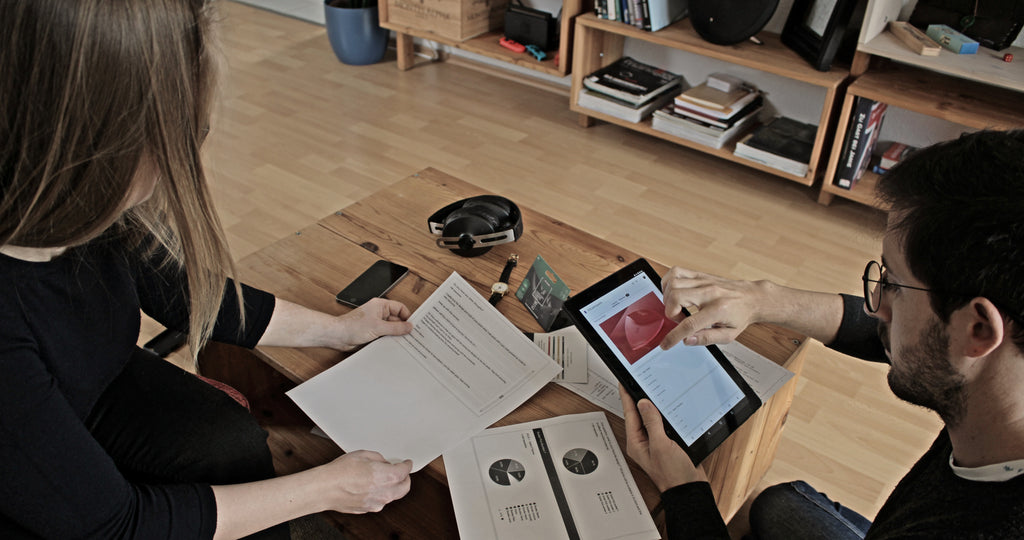
What is a signature guitar pick:
Signature guitar picks are common in the guitar pick world.
These picks were developed with the help of some expert and famous guitarists from a specific music field.
From our point of view, this is a very narrow design path that only considers the opinion and guitar playing style of one person.
Our approach: The opposite of a signature pick:
The guitar community has strongly supported Rombopicks since its beginning in 2019.
We did not want to create new guitar picks without asking the people who have been with us since the beginning. You guys and girls are the core of Rombo, and you should decide which products we develop.
The most logical step was to create a big survey to allow users to tell us how they prefer their guitar picks.
We think this is the only way to develop our guitar picks, based on the wants of our users, allowing us to make essential decisions about our company's direction.

This is only possible by listening to the thoughts of every guitar player.
In addition, by asking precise questions about guitar picks, we are able to create more awareness of complex issues, like: Why are guitar picks thick or thin? How they behave when the size changes? Does the flexibility of a guitar pick affect the tone? What about the material?
When the user is aware of the product features, he/she can deliver a useful vote.
Since the beginning, we have been researching all these areas and are sharing them with you. With every article about plectrums we have written, we have contributed to the knowledge you have about your gear so you will be able to decide which gear is the best for you and understand why.
The results of the survey:
Participants:
1.552 guitar players (including us) have participated in the survey and therefore have took part in the design process of these new guitar picks for 2021.
336 of them left a private message with detailed information.

What is your favorite guitar pick design?
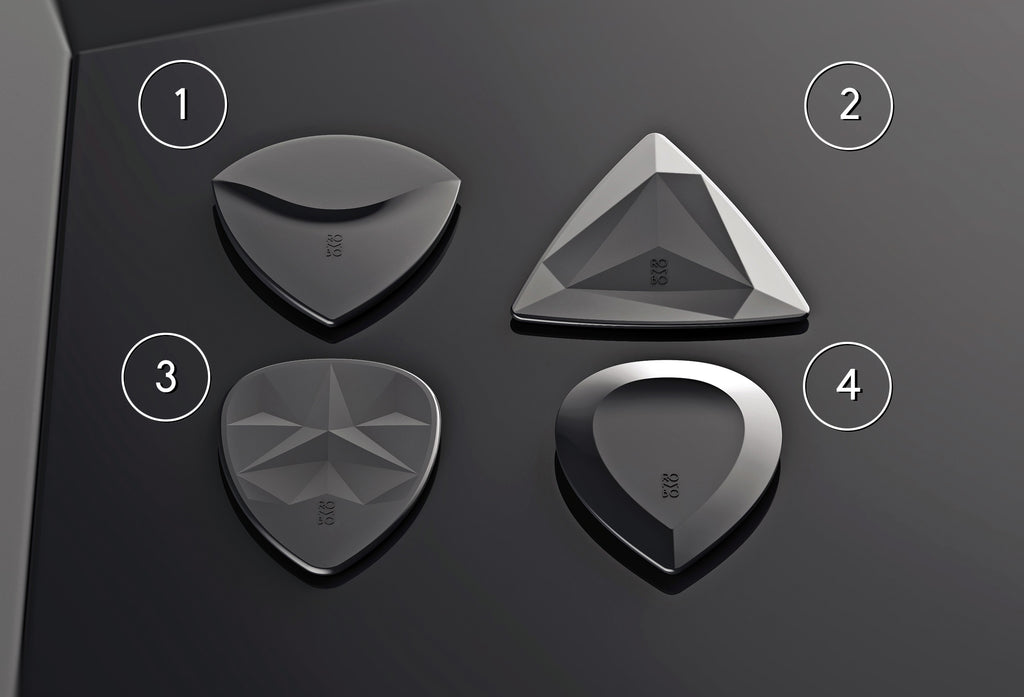
Pick number1: 18,8%
Pick number 2: 14,8%
Pick number 3: 27,8%
Pick number 4: 38,7%
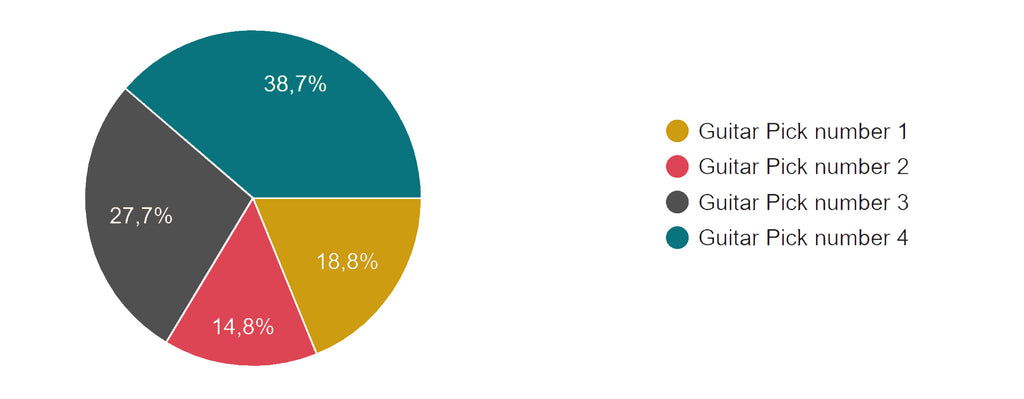
Guitar Pick Number 1:

Name:
Rombo Horizon: 34,5%
Rombo Sense. 33,9%
Rombo Summit: 14,1%
Rombo Mood: 7%
Other names: 10,5%
Average Thickness: 1,378 mm
Average Size: Medium Size with 71% of the votes
Guitar Pick Number 2:

Name:
Rombo Prisma: 76%
Rombo Spin: 7,7%
Rombo Treble: 8,4%
Other names: 7,9%
Average Thickness: 0,831 mm
Average Size: Large Size with 73,5% of the votes
Guitar Pick Number 3:

Name:
Rombo Crisp: 47%
Rombo Split: 22,1%
Rombo Prisma: 16,4%
Other names: 14,5%
Average Thickness: 1,028 mm
Average Size: Medium Size with 59,7% of the votes
Guitar Pick Number 4:

Name:
Rombo Jade: 33%
Rombo Shift: 17,6%
Rombo Slope: 12%
Rombo Summit: 10%
Rombo Dune: 7%
Rombo Cascade: 7%
Rombo Wizzard: 4,9%
Other names: 8,5%
Average Thickness: 2,37 mm
Average Size: Small Size with 56,6% of the votes
Guitar picks: Personal thoughts of 336 guitar players

A total of 336 people left us a private message regarding guitar picks.
We have read all of them carefully and we will use all this information during the development.
Here are the important questions we have received and our comments to them:
-
Will the guitar picks be available in new colors?
Not at the moment. However, we are thinking about creating some additional colors for special editions in the future.
-
Will they have the same grip structure?
Yes! Definitely. Lots of people have sent us e-mails and letters regarding the grip structure. With the micro-nodules, we have the advantage of medium-grip surfaces which add lots of control.
However, a very small number of people want the picks to have more grip. We had to make a decision here, and it was hard.
We won’t forget this topic: In the future, we want to develop a texture with more grip for these players.
-
Why don’t you create different guitar pick thicknesses for each one of the models?
We want every guitar pick to be unique. As every person has unique preferences, we believe every guitar pick should have its own design.
In the future, we hope to be able to create a bigger quantity of different plectrum designs to cover each possible necessity.
-
What about picks for bass players?
Most our picks are compatible with bass, as we have confirmed this with some bassists that are using them regularly, especially Rombo Diamond ad Rombo Origami. We explained this HERE.
-
You should create some merch, T-Shirts and other stuff:
Maybe in the future. Now, we want to focus 100% on the development of the guitar picks. Every minute we spend on the design of a T-Shirt will be taken away from the quality of the picks! ;)
-
Will you offer the EcoBlack range in other colors?
The EcoBlack material can only be produced in one color at the moment. The recycling process creates a very dark pigmentation. The industry is working hard to find a way to create new recycling processes. We hope we will manufacture all of our picks out of recycled material in the future.
When will be the new picks available?

The new guitar picks will be available in early 2021.
If you want to receive an E-Mail as soon as the picks are availabe, join our mailing list below on the footer.
This is the timeline we created for this project:
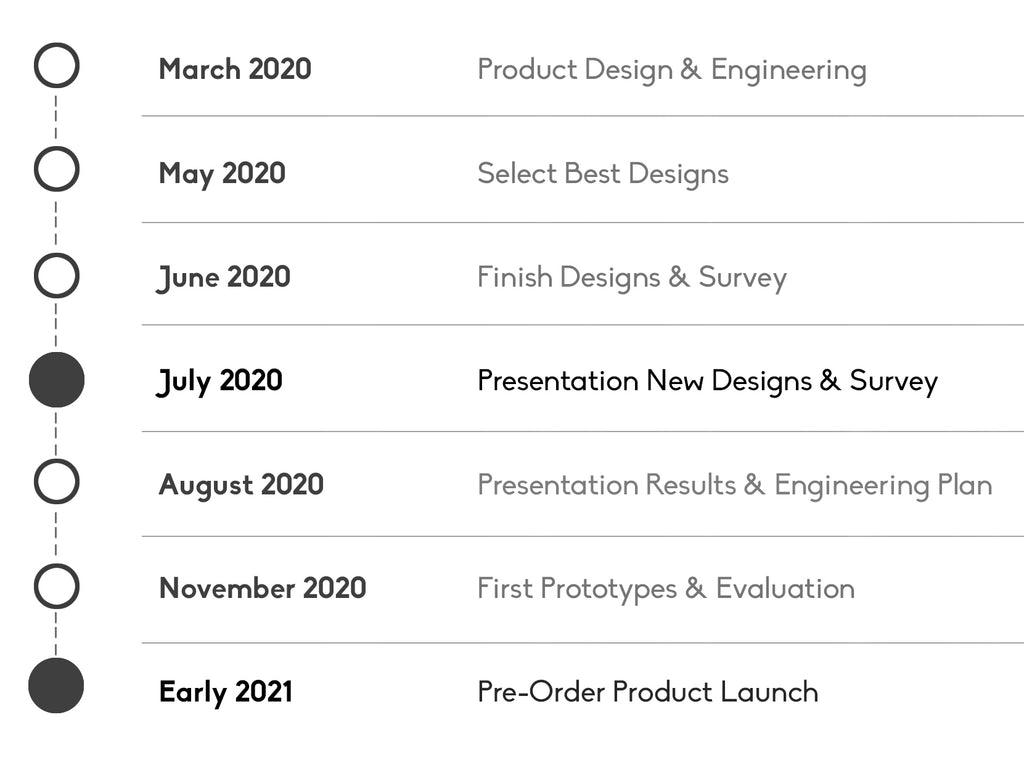
The pre-order product launch will be on the platform Kickstarter (like the first generation of Rombo guitar picks we launched in January 2019).
However, the current development of the Covid-19 could postpone the project a couple of months. We want to launch the product when we are able to deliver worldwide.
Why Kickstarter?
Kickstarter campaigns turn dreams and ideas into reality. Rombo is still a small start-up run by two people, and with limited access to resources. Through Kickstarter, we involve the community of guitar players, showing our guitar picks before launching.
This process brings us in contact with the real guitar players and their necessities. It forces us to remain flexible, accept changes, and challenges us to create new designs to fulfill the expectations of our audience.
We love open and critical criticism, and this is the best place to get it, where all comments and thoughts are visible. By sharing your experiences, we can listen to your needs and wishes, and create guitar picks that make a difference.

Guitar Pick Materials At Rombo
Guitar picks can really be made out of anything. In the past, some exotic materials were used to produce guitar picks.
The technological wave that came with highly specialized polymers created a new era of materials with amazing properties.
How The Material Of A Guitar Pick Influences Your Playing
The material of a guitar pick is strictly connected to its flexibility and tone. It is hard to imagine that such a small piece can have a big impact on playability.
However, you will clearly notice some sound differences when testing a couple of different guitar picks.
Luckily, these small useful gems are the cheapest guitar accessory you can acquire, allowing you to test many guitar pick models.

The Constant Search For The Perfect Tone
When it comes to guitar picks, changing the properties of a material is not an easy task.
Flexible guitar pick materials:
Flexible guitar pick materials can create mellow and warm tones when using specific guitar techniques. However, they can also achieve brighter tones when holding the pick very closely to the pointy tip or “attack area”. This is the reason they have been the go-to choice for guitarists for decades.
Stiff guitar pick materials:
Stiff guitar pick materials can create a snappier, bright tone that can be very delightful, provide more volume and more clarity to your chords and solo notes. These picks are often used for more specific guitar techniques by lead guitarists.
Material Isn't Everything
Thickness, shape and size will play an important role too!
Flexible guitar pick materials can create mellow, warm tones. However, when using plectrum thicknesses over 1 mm, the tone will get darker and heavier. This can be used to create the feeling of having more “bass” in your instrument. The same effect happens with the size. The more material you have, the heavier the sound will be.


We have a guide to find your guitar pick HERE. You will learn how these 4 attributes (material, shape, size, and thickness) are connected.
Finding The Materials For Rombo Guitar Picks:
Every guitarist has different preferences. Throughout our development, we have involved as many professional guitarists as possible, and asked them to define how their perfect material should feel.
We came to the following conclusions. The guitar pick material should:
- feel nice to the touch and be comfortable, yet provide grip
- be able to create clear tones, without compromising the bass tones
- be very versatile: feel flexible when thin and feel stiff when thick
- be durable
- look nice
With these premises, we started our long journey: the search for a suitable material.
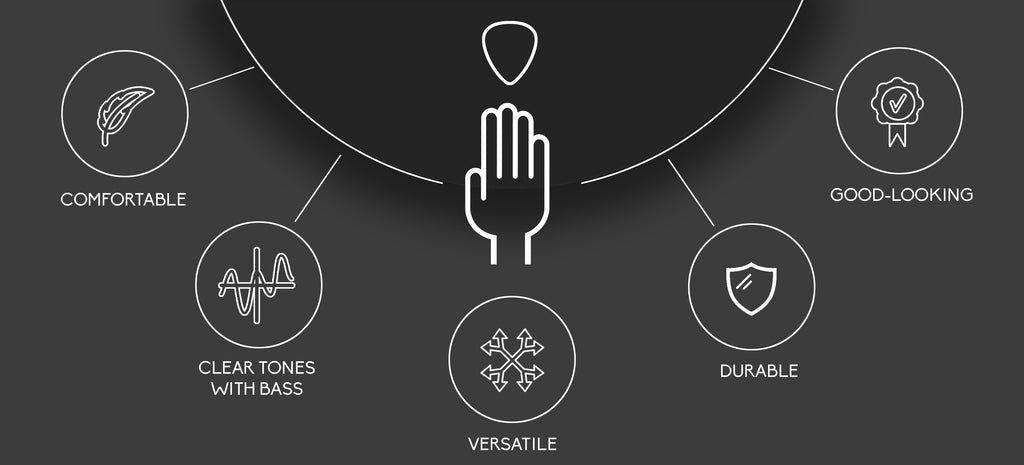
After lots of tests, feedback rounds and sending dozens of pick prototypes around the globe to our guitar pick testers, we think we`ve found it!
Guitar Pick Materials At Rombo
We are using a thermoplastic polymer that belongs to the family of the polyamides. This material is used in aerospace and automobile industries and has the following properties:
- High-mechanical strength
- Versatile (rigid or flexible -depending on the treatment and thickness)
- Excellent impact resistance (guitar strings)
- Superior aesthetic properties
- Medium / low friction
The raw material we use is produced in Italy. We have worked very closely with our material partner to accomplish every requirement we had, including the 100% recycled material of the EcoBlack sets.
We believe we have achieved an excellent balance between, sound, comfort, aesthetic properties, and durability.
Combined with well-thought ergonomic designs, different textures, and very good quality control of the process, this material can accomplish all 5 premises we defined above.


Eco-Black Range: 100% Recycled Guitar Picks
We are also experimenting with recycled materials. In our “ECO-Black" range, we offer the same material formula, but use 100% recycled material from pre-consumer waste.
In this product range, the guitar picks are only available in Graphite Black. Currently, this is the only color we can produce when using this compound.

In addition, during compound manufacturing, there are 90% less emissions, 65% energy reduction, and a 61% reduction of total resources.
We will continue our hard work in this area and someday in the future, we will be able to create colored guitar picks out of this material. When this day comes, all of our guitar picks will be 100% recycled.
Read more about the Eco-Black range and the recycled guitar picks in our article "ROMBO Unveils New “Eco-Black Range Guitar Pick Models".
Conclusion:
Finding a material you feel comfortable with is not an easy task, but you will have lots of fun along the way.
We believe material development is fundamental to ensure a future of plenty of functional, good-looking and environmentally friendly materials.
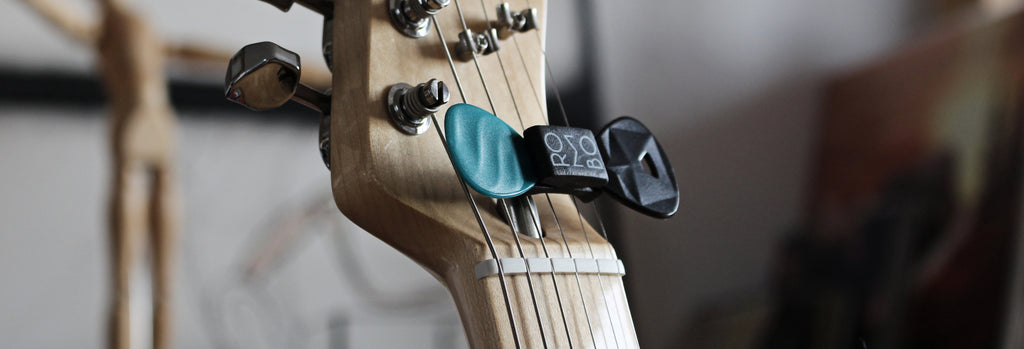
Did you find this information useful?
Share this article with friends to help us with our mission: vote for development, for the implementation of new ideas and for questioning deep-rooted standards to find something better.
Thank you!
Folge uns
Judith Heindorf & Carlos Diez Macia GbR
Auf der Steige 29
71686 Remseck am Neckar
DEUTSCHLAND
- Shop
- Händler
- Impressum
- AGB
- Widerrufsrecht
- Versandbedingungen
- Datenschutzerklärung
- Kontakt
- Presse
- Fragen & Antworten
Melde dich zu unserem Newsletter an und erhalte alle Neuigkeiten zu Sales, Neuerscheinungen und vielem mehr…
Mit der Anmeldung stimmst du unseren Datenschutzbedingungen zu.
© 2025 ROMBO.
ist eine registrierte EU-Marke.
Wir nutzen Shopify.


